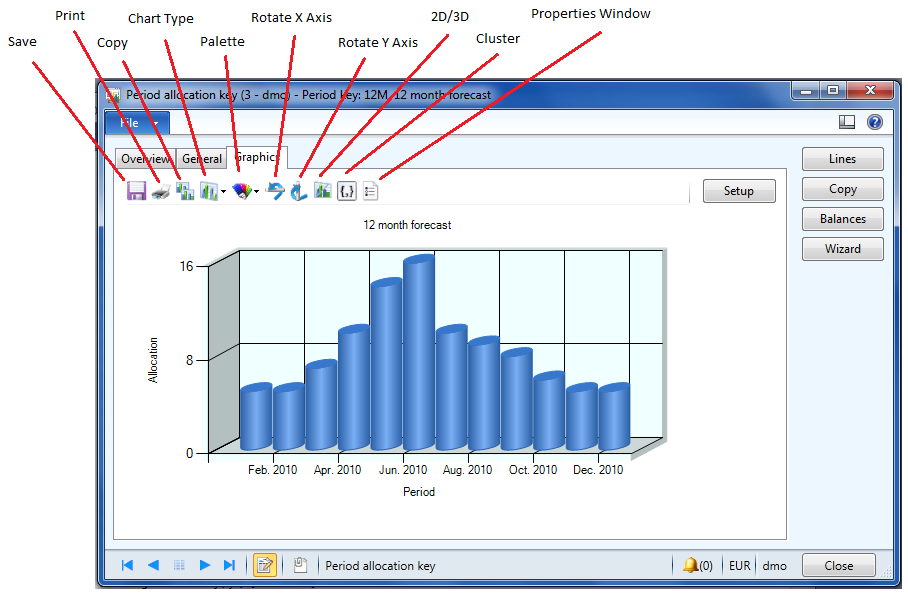Charts in Microsoft Dynamics AX 2012
Microsoft Dynamics AX 2012 has integrated support for Microsoft .NET charts, easily managed via X++.
- The Microsoft .NET team has extended the .NET API by introducing a Chart control.
- Microsoft Dynamics Client enables simple use of this control by creating a new X++ wrapper class for the MSChart control: Graphics.
- The Microsoft Dynamics Client has introduced a new companion control for the MSChart control: The Chart Toolbar control.
With the Graphics class, an X++ developer can easily display their data graphical manner, without the need to utilize and understand the low-level .NET charting API. Simply utilize the Graphics class to initialize a chart with default display values, call a single "add data" API, then call Update to diplay the chart. In most cases, the developer will also want to provide the end user with the ability to manipulate the chart at runtime. In those cases, the developer will add the new Chart Toolbar to his form, and pass the toolbar an instance of the chart to be manipulated. That's it. An example use of charting can be found in the Tutorial_Form_Graphics form.
Start by adding Two Managed Controls to your form. One to host the Chart Control, the other to Host the Chart Toolbar
For the purposes of this example name the chart control instance is "GraphControl"
Assembly: System.Windows.Forms
Control: System.Windows.Forms.DataVisualization.Charting.Chart
Assembly: Microsoft.Dynamics.AX.Framework.Client.Controls
Control: Microsoft.Dynamics.AX.Framework.Client.Controls.ChartToolBar
Set both to have a Width of Column Width
// Class Declaration
public class FormRun extends ObjectRun
{
Graphics graphics;
Microsoft.Dynamics.AX.Framework.Client.Controls.ChartToolBar chartToolbarControl;
}
public
void init(){
super();
// create an runtime reference to the toolbar control
chartToolbarControl = chartToolbarControlHost.control();
// bind the tool bar to the chart control by passing an instance of the chart control to it
chartToolbarControl.set_ChartControl(graphControl.control());
this.createSampleData();
this.showchart();
}
void showchart()
{
// create an instance of the X++ to .NET abstraction class and bind it to the chart control
graphics = new Graphics();
graphics.ManagedHostToControl(graphControl);
// set your abstracted chart options
graphics.parmCreateType(#CT_LEGEND | #CT_3D);
graphics.create();
graphics.parmTitle("@SYS95906");
graphics.parmTitleXAxis("@SYS106478");
graphics.parmTitleYAxis("@SYS3065");
// populate the chart with data
whileselect tmpAccountSum
orderby TransDate
{
graphics.loadData( date2str(tmpAccountSum.TransDate,-1,-1,-1,-1,-1,-1, DateFlags::None), tmpAccountSum.Txt, tmpAccountSum.Qty01);
}
graphics.showGraph();
}
// create some sample data
void createsampledata()
{
tmpAccountSum.TransDate = 01\01\2007;
tmpAccountSum.Qty01 = 1;
tmpAccountSum.Txt = 'Group1';
tmpAccountSum.insert();
tmpAccountSum.TransDate = 02\02\2007;
tmpAccountSum.Qty01 = 2;
tmpAccountSum.Txt = 'Group1';
tmpAccountSum.insert();
tmpAccountSum.TransDate = 02\02\2007;
tmpAccountSum.Qty01 = 1;
tmpAccountSum.Txt = 'Group2';
tmpAccountSum.insert();
tmpAccountSum.TransDate = 03\03\2007;
tmpAccountSum.Qty01 = 3;
tmpAccountSum.Txt = 'Group2';
tmpAccountSum.insert();
tmpAccountSum.TransDate = 04\04\2007;
tmpAccountSum.Qty01 = 1;
tmpAccountSum.Txt = 'Group1';
tmpAccountSum.insert();
tmpAccountSum.TransDate = 04\04\2007;
tmpAccountSum.Qty01 = 2;
tmpAccountSum.Txt = 'Group3';
tmpAccountSum.insert();
tmpAccountSum.TransDate = 05\05\2007;
tmpAccountSum.Qty01 = 3;
tmpAccountSum.Txt = 'Group3';
tmpAccountSum.insert();
tmpAccountSum.TransDate = 05\05\2007;
tmpAccountSum.Qty01 = 2;
tmpAccountSum.Txt = 'Group2';
tmpAccountSum.insert();
}
